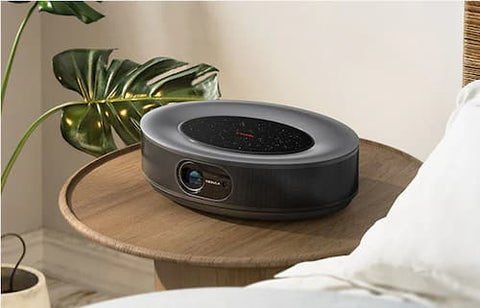Where to place the projector?
Projectors have become versatile tools that are equally well-used for home presentations and business presentations. To ensure optimal image quality, it is important to consider the distance between your projector and the screen you will be projecting onto. While there is no one-size-fits-all answer, understanding the factors that go into calculating the proper throw distance can help ensure your presentation is at its best. Here, we will discuss how far a projector should be from the screen and the essential details about the projector-to-screen relationship so that you can achieve optimal viewing quality every time!
Relationship between screen size and projection distance

Essentially, the larger the screen size you want to be, the further away your projector should be from the screen. Conversely, if you have space constraints and a smaller room, you may need to position the projector closer to the screen. However, before we dive into the details of projector-to-screen distance, let’s establish a fundamental concept: throw ratio.
A projector's throw ratio is a fundamental specification that expresses the relationship between the projector's distance from the screen and the resulting image size. In essence, it quantifies how wide or narrow the projected image is based on a specific distance.
Throw ratio is usually expressed as a ratio, such as "1.5:1" or "2.0:1," where the first number represents the distance from the projector and the second number represents the width of the image. For example, a projector with a throw ratio of 1.5:1 will present a 100-inch-wide image when placed 150 inches from the screen. It is essential to understand the relationship between screen size and projector projection distance thanks to the projection ratio concept to obtain an optimal viewing experience in your home cinema or multimedia installation.
How does projector distance affect image quality?

The distance between the projector and the screen or wall is not just about installing a screen in a room; it also significantly influences the quality of the projected image. The main factors affected by the projector distance are:
Image size and clarity
Distance determines the size of the projected image. If the projector distance is too close, you will get a smaller image that may not fully utilize the screen space. Conversely, if it is too far away, the image may become larger than the screen, which can cause parts of the image to bleed or become distorted.
Image brightness
Projectors have specific brightness values, which indicate how bright they are. The further the projector is from the screen, the darker the image becomes. This is especially important if you plan to use the projector in a well-lit room or if you want a bright, high-contrast image.
Keystone correction
Keystone correction adjusts the projected image to make it square and remove distortion. Placing the projector too far from the screen may require more aggressive keystone correction, which can degrade image quality.
Projection ratio compatibility
Each projector model has a specific throw ratio, which determines its ideal distance for a given screen size. A significant deviation from the manufacturer's recommended throw ratio can result in poor focus, which negatively affects image quality.
Uniformity and Hotspotting
The distance from the projector can affect the uniformity of brightness across the screen. If the projector is too close, you may experience hot spots, where the center of the screen appears significantly brighter than the edges. Conversely, if it is too far away, you may experience uneven brightness.
In summary, finding the right distance between the projector and the screen is essential to achieve the desired image quality. If necessary, seek advice from a manufacturer professional to ensure you get the best image quality for your specific projection setup.
How far should a projector be placed from the screen?

To help you determine the projector-to-screen distance for common screen sizes such as 80 inches, 100 inches, and 120 inches, we provide approximate distance ranges based on a standard environmental throw ratio. 1.5 to 2.0:
Projector distance for 80 inch screen
Recommended range: approximately 8 to 12 feet.
This range allows you to get a good sized 80 inch image without compromising image quality. You can adjust this range based on your projector's throw ratio and specific setup preferences.
Projector distance for 100 inch screen
Recommended range: approximately 10 to 15 feet.
By projecting the projector in this range, you ensure that you can enjoy a wide and immersive 100-inch image while maintaining good image quality and brightness.
Projector distance for 120 inch screen
Recommended range: approximately 12 to 18 feet.
To get a cinematic experience on a 120-inch screen, position the projector within this range. This provides an expansive and immersive viewing experience.
These are general guidelines based on common throw ratios. The actual distance between the projector and the screen may vary depending on the specific throw ratio of the projector. Always check the specifications on the models official website of spotlights to ensure accurate placement and optimal image quality. Additionally, consider factors such as room size and layout when determining the final projector-to-screen distance for your setup.
Choosing the right projector-to-screen distance is a critical step in creating a home theater setup that meets your expectations. By understanding the relationship between screen size and throw distance and how far a projector should be placed from common screen sizes, you can make an informed decision about the best projector-to-screen distance that ensures an engaging and enjoyable viewing experience.
